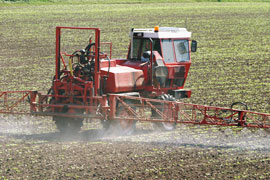Timing is key for sugar beet weed control in dry conditions

Continuing dry conditions could compromise pre-emergence herbicide efficacy in sugar beet, which may force growers to revisit herbicide strategies later this spring.
To ensure good weed control, growers should consider the actives they use and their timing to get the maximum effect from their herbicide programme.
Keeping spray intervals short is a key principle in controlling weeds in sugar beet, advises AICC sugar beet specialist Pat Turnbull.
“Growers should be aiming to take the weeds out when they are small,” she says.
Monitor crops closely and be ready to spray before the weeds become obvious, she advises.
“Growers shouldn’t be tempted to wait for more weeds to emerge, they would be much better spraying them in their early growth stages.”
Early applications are particularly important in dry conditions, as weeds tend to harden quicker and become more resilient. Active choice will also be important in a high weed pressure year.
“Desmedipham in particular, has been found to be important in dry years and should be considered early on in combination with phenmedipham in the herbicide programme,” says Dr Turnbull.
“Growers could also consider ethofumesate as an active that will fit into the herbicide regime,” says Pam Chambers of Brooms Barn Research centre.
But she stresses that the total amount of ethofumesate that can be used is 1,000g/ha over a three-year period.
Dr Turnbull also advises growers to consider adjuvant choice and the use of an oil, as they are able to increase the penetration of herbicides in dry conditions.
For example, knotweed can be taken out with the use of phenmedipham, desmedipham, metamitron and an oil, she says.
Spraying in the morning or late in the evening might also have some benefits, as growers can make the most of any moisture that might be about.
Case study: Brooms Barn
The Brooms Barn research centre in Suffolk has been carrying out sugar beet trials for the past two years, and last year’s dry conditions proved particularly challenging for good weed control.
“Last year we saw increased pressure from weeds including blackbind weed, fat hen, blackgrass, volunteer oilseed rape and knotgrass,” says Pam Chambers.
“Black bindweed and knotgrass were particularly hard to control.”
“Blackgrass was also an issue in sugar beet,” says Ms Chambers, who adds that in some cases blackgrass showed resistance to graminicides.
Volunteer oilseed rape was also seen in sugar beet trials, though appearing later in mid June.
“This year we have noticed that sugar beet drilled at the end of February, beginning of March, in damper conditions, is already starting to emerge along with the weeds.”
Summary
• Apply herbicides early to catch growing weeds
• Consider the use of actives
• Spray early morning or late evening
• Use an oil or adjuvant to increase penetration
Potato growers have time to adjust their strategies
Potato growers in dry areas have time to adjust their herbicide strategy to counter the effects dry conditions can have on pre-emergence sprays.
“The majority of crops will have at least another two weeks until emergence, so growers should adjust tactics accordingly,” advises John Keer, development agronomist for Richard Austin Associates.
“If we don’t get rain, then pendimethalin might not be effective, the same could be said for clomazone options,” he says.
“In dry conditions potato growers should hold back on pre-emergence application so they are as close to the point of emergence as possible,” advises Stephen Williams, Syngenta technical manager.
“This tactic might not always be practical for growers covering large areas though, as they may not be able to cover the ground at relatively short notice,” he adds.
Dr Keer advises that growers might also want to consider using a contact as part of the pre-emergence mix to kill off weeds that may have already emerged.
“If we do get a shower, it will be important growers make the most of it, and apply their pre-emergence herbicides as soon as possible after,” he says.

